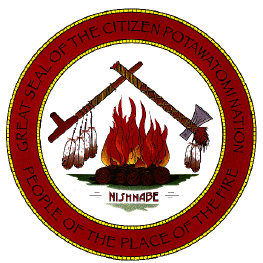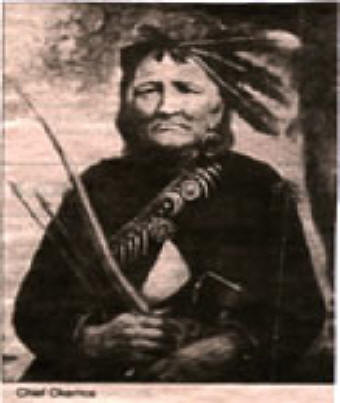|
||||
|
|
||||
| The Pottawatomi is a tribe that was believed to come to North America between 1765 and 1795. The Pottawatomi mainly lived around the Great Lakes or around Michigan, where they first moved onto land to live on. It is believed that the Pottawatomi moved around alot, but mainly around the Great Lakes or around Michigan lands. The Pottawatomi were Algunquain-speaking people who lived by the Great Lakes. The Pottawatomi were believed to travel down the shores of the Atlantic Ocean. "Pottawatomi" is believed to be made by the Chippewa. | ||||
|
|
||||
| The Pottawatomi mainly were called the Neshnabek before they were called the Pottawatomi. Neshnabek means "The People" and Pottawatomi meaning "The People of the Place of the Fire", which is written on the Citizen Pottawatomi Nation's symbol, along with other Pottawatomi things. Pottawatomi is spelled many different ways, Pottawatomi can be spelled Pottawatomi or Potawatomi, and the are probably other spellings too. Pottawatomi got there name from the Ojibwe, when they were a tribe of the Algonguin race. The Odawas were also included in the tribe with the Pottawatomi. As the Pottawatomi learned many things as they moved from place to place. They learned suck things as how to use snowshoes, tabaggons, and canoes. Other Indian tribes didn't know how to use these things, so the Pottawatomi had a advantage over them. The Pottawatomi also learned a clan system and followed it. They couldn't marry inside of a clan by following the system. The Pottawatomi had a leader inside each clan, instead of having one main tribal chief. They learned how to farm from the Sauk, Fox, Kickapoo, and Winnebago between 1630-1700. In 1600 when the Pottawatomi was threatened by the Ontario they moved from lower Michigan to the Westside of Lake Michigan in northern Wisconsin in 1641. All or most all Pottawatomi were living in Wisconsin's Door Peninsula in 1665. Around 1760 the Pottawatomi expanded themselves into central Illinois and northern Indiana. Around the 1830's when removal to Kansas and Iowa was happening some of the Pottawatomi Indians escaped to Canada | ||||
|
|
||||
| Neshnabek, the Pottawatomi, also meant True People. When a man called Wiske, the Pottawatomi called him Master of All Life, met the Neshnabek he taught the Neshanbek how to make and use bark canoes, pottery, bows and arrows, bark and rushing mat covered wigwams. Wiske also taught the Pottawatomi how to use animals and plants. The Neshnabek also learned how to divie into families, clans, and villages, each of the families, clans, or villages had a wkama or chief. From Wiske the Pottawatomi learned how to protect themselves by rituals, and also learned the importance of their dreams and visions. All that said about Wiske and the Pottawatomi all came from a Pottawtomi Genesis. The Pottawatomi had many origin myths, infact each caln had it's own myth of how a founder got their special power to create a new clan it is said that they got their special power from their visions. The Neshnabek even had myths of how people got their horses and why women shouldn't be chiefs. Wiske was just one of the many examples of the Pottawatomi's culture heroes. Theses myths of the Pottawatomi also had symbolism in each of them. | ||||
|
|
||||
| In 1641 Jesuit missionaries learned of the Pottawatomi's plan to flee from Michigan lands to west of Lake Michigan. When the Pottawatomi did flee it made a panic for the horticultural tribes of Michigan. Armies came from the East for what Jesuits called "wars of extermination". This army was from the Ontario Peninsula and were called the Neutrals by the French, because their territory was between warring tribes. In later years, when the Neutrals of French had attacks on them, it destroyed the Neutrals of French and related tribes in Ontario. After 1680, when the Iroquois were assaulting tribes south of the Great Lakes, the Pottawatomi were taken captive. The Pottawatomi escaped to avoid invaders, and escaped to the shores of Green Bay. When they escaped to the shores of Green Bay the were joined by the Sauk, Fox, Kickapoo, Miami, and other tribes trying to avoid invaders. In 1653 New York Iroquois sent a army to destroy the tribes that were around Wisconsin, this included the Pottawatomi. | ||||
|
|
||||
| The tribes learned of the army that was sent to destroy the tribes. The tribes were gathering forces to defend themselves, the Pottawatomi was the largest force with 400 out of the 1,000 defenders. The Pottawatomi made a fortified village called Mitchigam meaning "Great Lake", on the eastern shores of the Door Peninsula. When the New York Iroquois tried to destroy the tribes, they couldn't win so they stoped trying to defeat the tribes. The Pottawatomi offered a feast to the New York Iroquois, but when they had the feast the Pottawatomi feed the New York Iroquois Poisoned corn. After words the Iroquois fled and were almost destroyed by the tribes. The Iroquois even tried two more times to destroy the tribes, but the Iroquois just couldn't destroy the tribes. In the end the Pottawatomi ended up destroying the Iroquois. Destroying the New York Iroquois made it unsafe for the Iroquois who were living around Green Bay. |
Chief Okemos |
|||
|
|
||||
| Nicholas Perrot was a trader sent by the French King, he spent a lot of his years with the People, also known as the Pottawatomi. Nicholas was also known to the Pottawatomi as Father Claude Allouez. The Pottawatomi wasnted to get recognition, prestige, and influence among other tribes by tradeing. The Pottawatomi wanted to become brokers of fur trading. Nicholas Perrot didn't know about the Pottawatomi's plans, but when Nicholas did find about the Pottawatomi's plans he tried to stop the Pottawatomi, for the loyalty to his king, They had a council over the Pottawatomi's plans in 1668, and from the council the Pottawatomi finally got what they wanted. After Perrot left the Pottawatomi they invited Claude Allouez back to live with them to subdue the carousing of the rowdy Frecnh traders. Although Claude was wanting to make converts of the Pottawatomi. Allouez lured the Pottawatomi's strength and comforts of their traditional faith. Allouez's work threatened the integrity of the Pottawatomi's culture. Allouez wasn't successful though, and was sent away by the Pottawaomi. The French were supernatural creatures when the Pottawatomi first heard of the French. When the Pottawatomi met the French they only knew of the males, the females wouldn't go to the western lake country's for years. Since the French women wouldn't go to the lands the French had Indian mates front the tribes that they lived with. The Pottawatomi men gave their daughters to French men to marry or just for a mate, it was called "the custom of the country", so they could alliances with the French. | ||||
|
|
||||
| Jean Nicolet was the first to bring contract between the Europeans and the Pottawatomi. Jean was also called Red Bank, by the Pottawatomi. Seven Crumbo was a very good known Pottawatomi artist, Seven's murals are hung on the walls of the Department of Interior Building in Washington, D.C. When the Pottawatomi trapped furs, they wanted to sell the furs, and later it expanded very big. While the Pottawatomi men hunted for game, the Pottawtomi women would grow crops when they were able to. They would use game skins as clothing, but when they traded the game furs they replaced the fur with cotton shirts among other clothing. The men would ware fur and the women would ware skirts among other clothing with each. Tapping Maple trees for sugar was a major social event for the Pottawatomi. They would get together and dance with the men playing drums. They also had flutes made from bones that they would play. Instead of salt to flavor food. The Pottawatomi also used easy ways to live among the land when they had these events. | ||||
|
|
||||
| The Pottwatomi used war clubs during war and used bows and arrows. During hunting they would use fish nets and fish spears. The white man took most of the Pottawatomi land, making them move futher away from there own land by 1800. During the Removal Period of the 1830's the Pottawatomi was moved from Indiana to Kansas, covering around 660 miles, 40 out of 850 Pottawatomi died covering the march. The 1838 removal of the Pottawatomi is called "Pottawatomi Trail of Death", which was from September to November 1838. During the removal the Pottawatomi moved to a small reserve in Kansas. When the Pottawatomi interacted with the Sioux, in Kansas, they adapted life ways from the Sioux. The Pottawatomi sold there land to purchase Indian Territory in 1867. Tribal members of the Pottawatomi took U.S. citizenship, so instead of being called Mission Pottawatomi they were called "Citizen Pottawatomi". Most of the Citizen Pottawatomi were settled in Indian Territory in Oklahoma, by the early 1870's. When the Pottawatomi Indians lived in Kosciusko land by 1832 alcoholism, disease, and hunger had made it so that only one-tenth of the Pottawatomi Indians still lived there. The Pottawatomi really like whiskey, because they didn't have anything to relieve pain, but whiskey relieved pain for them. One of the Pottawatomi Indian chief, in the 1820's and 30's would buy whiskey by the gallons. | ||||
|
|
||||
| During the 'dust bowl" many of the Pottawatomi tribal members, following the patterns of the Oklahomans, migrated to California, Washington, Colorado, Idaho, and Oregon. The Citizen Pottawatomi Nation is the ninth largest tribe in the U.S. The Citizen Pottawatomi Nations owns many programs. Among the programs that the Citizen Pottawatomi Nation owns are the First National Bank and Trust of Shawnee, Fire Lake Entertainment Center , and a Child Development facility. The Child Development facility had over 250 children go there each day. The founding of the Catholic Mission, in St. Marys, Kansas, was made from the Pottawatomi beating the Pawnees. The Citizen Pottawatomi Nation Tribal Enrollment is around 24,500 people to this day. |
 The Citizen Pottawatomi Seal |
|||
|
|
||||
|
Brian Hudson 8th American History Rossville Jr. High Plains History Project 2004 |
||||


